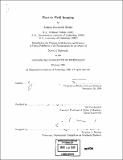Electric field imaging
Author(s)
Smith, Joshua Reynolds
DownloadFull printable version (25.81Mb)
Advisor
Neil Gershenfeld.
Terms of use
Metadata
Show full item recordAbstract
The physical user interface is an increasingly significant factor limiting the effectiveness of our interactions with and through technology. This thesis introduces Electric Field Imaging, a new physical channel and inference framework for machine perception of human action. Though electric field sensing is an important sensory modality for several species of fish, it has not been seriously explored as a channel for machine perception. Technological applications of field sensing, from the Theremin to the capacitive elevator button, have been limited to simple proximity detection tasks. This thesis presents a solution to the inverse problem of inferring geometrical information about the configuration and motion of the human body from electric field measurements. It also presents simple, inexpensive hardware and signal processing techniques for making the field measurements, and several new applications of electric field sensing. The signal processing contribution includes synchronous undersampling, a narrowband, phase sensitive detection technique that is well matched to the capabilities of contemporary microcontrollers. In hardware, the primary contributions are the School of Fish, a scalable network of microcontroller-based transceive electrodes, and the LazyFish, a small footprint integrated sensing board. Connecting n School of Fish electrodes results in an array capable of making heterodyne measurements of any or all n(n - 1) off-diagonal entries in the capacitance matrix. The LazyFish uses synchronous undersampling to provide up to 8 high signal-to-noise homodyne measurements in a very small package. The inverse electrostatics portion of the thesis presents a fast, general method for extracting geometrical information about the configuration and motion of the human body from field measurements. The method is based on the Sphere Expansion, a novel fast method for generating approximate solutions to the Laplace equation. Finally, the thesis describes a variety of applications of electric field sensing, many enabled by the small footprint of the LazyFish. To demonstrate the School of Fish hardware and the Sphere Expansion inversion method, the thesis presents 3 dimensional position and orientation tracking of two hands.
Description
Thesis (Ph.D.)--Massachusetts Institute of Technology, School of Architecture and Planning, Program in Media Arts & Sciences, 1999. Includes bibliographical references (p. 213-216).
Date issued
1999Department
Program in Media Arts and Sciences (Massachusetts Institute of Technology)Publisher
Massachusetts Institute of Technology
Keywords
Architecture. Program in Media Arts and Sciences